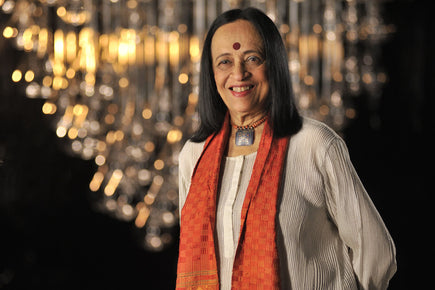Thota Vaikuntam's Art - An Everlasting Ode to His Village
His paintings depict feminine beauty of a different kind. They neither portray the ‘slim’ and ‘light-skinned’ damsel of popular culture, nor do they seek to make a statement through overly worked or distorted illustrations of women.

(An untitled artwork by Vaikuntam)
Thota Vaikuntam simply binds himself to his rural roots and creates soothing, powerful art, that embodies feminine and rural beauty as he knows it. He paints the quintessential Telangana people of his childhood, the ones he has grown up around, and the ones he is most familiar with.

(Telangana Folks I, 2015)
Early Experiments
Thota Vaikuntam was born in 1942 into the intensely rustic surroundings of Burugupalli village, in South India. The verdant village of his childhood played a huge part in inspiring the artist in Vaikuntam, even after he moved to the urbane surrounding of Hyderabad in his later years.

His fascination with the female figure began during his childhood days, when he used to be enamored by travelling theatre groups that had men impersonating women. In fact, his earliest experiments with art in childhood, were sketches of the various characters – Rama, Hanuman, Krishna and Ravana, that he saw in these dramas.

(Untitled, 2013)
A Student of Art
Despite their impoverished background, his parents allowed Vaikuntam to pursue an arts education. He completed a degree in Painting at the College of Fine Arts, Hyderabad and then studied at the famed School of Fine Arts at MS University, Baroda under the guidance of the eminent K.G. Subramanyan.
During his years in Baroda, he came across discussions around “what constituted Indian art”. Vaikuntam became disenchanted when he realized that it was the western way of painting that was being adopted at the time. Post his education, he struggled with distancing himself from European art, and finding an Indian identity for his art.
 (Artworks depicting pandits; click to purchase on Artisera)
(Artworks depicting pandits; click to purchase on Artisera)
Discovering His Identity in Telangana Women
In his search of a distinct Indian identity, Vaikuntam found inspiration in his native village roots. He made several charcoal sketches of the village women in an attempt to capture their beauty and vibrancy.

Some of these were an imagery of his mother in her traditional attire. Vaikuntam was deeply private about these early sketches as he was intimidated by the sensuality of his female forms.

Slowly, he started painting women who were unabashedly dusky, voluptuous and rural. They were decorated, with multiple bangles, hair accessories, bright sarees and big nose rings. Instead of the frequently seen delicate or graceful bindi, his women came with turmeric smeared foreheads layered with an enormous vermillion bindi.
 (Artworks depicting women; click to purchase on Artisera)
(Artworks depicting women; click to purchase on Artisera)
The women Vaikuntam painted were not village belles, but strong matriarchs. And these “Telangana women”, outlined with fluid charcoal lines and draped with decorative detail, became Vaikuntam’s unique identity, travelling the world on his canvas.

Changed, Yet the Same
Vaikuntam’s art has always been, and continues to be about his rural roots. But over three decades, his paintings have evolved in their form and characteristics. Men, earlier consigned to a minor role, now make a larger appearance within his paintings.

(Telangana Couple I, 2015)
His canvases have transformed from tight frames featuring a single woman, to those that include groups of women almost in their entirety.

(Untitled, 2014)
Today, the term “A Vaikuntam” refers to a canvas pulsating with primary colours and decorative finesse. But most of all, it refers to flat illustrations of village folk, specifically the almond-eyed women exuding beauty and strength in their true representation - dark, rustic, and distinctly Indian.



















































































 (Mother and Child; click to purchase on Artisera)
(Mother and Child; click to purchase on Artisera)





